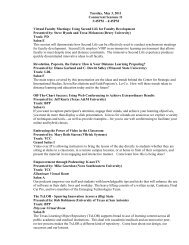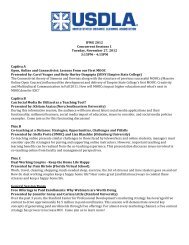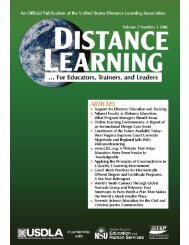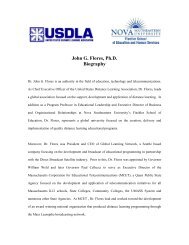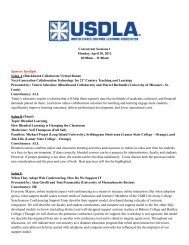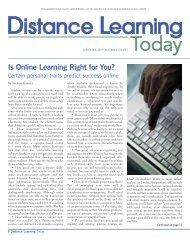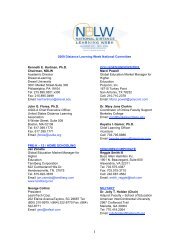United States Distance Learning Association
United States Distance Learning Association
United States Distance Learning Association
- No tags were found...
You also want an ePaper? Increase the reach of your titles
YUMPU automatically turns print PDFs into web optimized ePapers that Google loves.
concerning barriers to elearning and a few<br />
recommendations to help ameliorate them.<br />
DISTANCE TRAINING IN THE<br />
WORKPLACE<br />
Managers in organizations are usually<br />
effective at managing projects and programs.<br />
Additionally, in successful enterprises,<br />
much of the overall strategic level<br />
planning is well done. However, what I<br />
have suggested is that there are stages or<br />
levels of technological capability within<br />
the organization with regard to technology-enhanced<br />
learning and distance education<br />
(Berge, 2001b; Schreiber & Berge,<br />
1998). Once managers become aware of<br />
these levels of technological maturity, and<br />
aware of the relationship among project<br />
management, program management, and<br />
strategic planning, a better understanding<br />
may be gained concerning the need for<br />
change management to link these elements.<br />
TECHNOLOGY AND SOCIETY<br />
The same technologies that are fueling<br />
changes in the global economy and driving<br />
the growth of what is called the learning<br />
organization are also fueling the need for<br />
lifelong education for both organizations<br />
and individuals. Not surprisingly, this<br />
trend is also transforming how we deliver<br />
training in the workplace (Bachman, 2000;<br />
Moe, Bailey, & Lau, 1999). Technologybased<br />
learning and distance training can<br />
help to solve business problems. Trainingat-a-distance<br />
can improve the quality of<br />
learning and worker performance in an<br />
organization in a cost effective way while<br />
taking advantage of opportunities to<br />
increase competitive advantage in the marketplace.<br />
The power of training-at-a-distance is in<br />
its use of models different from the traditional<br />
approach to training. This traditional<br />
approach usually involves a “stand and<br />
deliver,” in-person presentation by a<br />
trainer, who is located in the same physical<br />
space as the trainees. With elearning, adult<br />
learning principles are often used to<br />
design and develop an active, authentic<br />
problem-solving learning environment that<br />
often focuses on collaboration and teamwork.<br />
WHY ALL THE FUSS<br />
Why all the fuss Why should changing<br />
culture, economic conditions, and theoretical<br />
stances influence the way education<br />
and training occur Specifically, why<br />
change how training is done and why do<br />
so now In today’s economic climate incremental<br />
improvements are often not<br />
enough. Significant changes within an<br />
organization ultimately come when the<br />
chief executive officer feels enough pain.<br />
Such pain can come from several sources:<br />
external mandates, often from government;<br />
corporate mergers; economic competition;<br />
and self-awareness/education<br />
regarding how organization can better<br />
meet goals (Berge, 2001a). Simply put, for<br />
companies and corporations to remain viable<br />
and profitable, the marketplace will not<br />
allow “business as usual” with regard to<br />
talent management.<br />
It is possible to significantly improve<br />
much of the training and education that is<br />
done by using a learner-centered, collaborative,<br />
social, constructivist approach. To<br />
do this can mean improvement in performance<br />
and employee competencies on an<br />
order of magnitude that exceeds what can<br />
be achieved by didactic methods. It is this<br />
order of magnitude change in the workplace<br />
that necessitates changes to the<br />
expectations, roles, and responsibilities of<br />
instructors, students, and managers as the<br />
organization builds capacity for technologically<br />
enhanced learning of mission-critical<br />
problems. Technology is a catalyst for<br />
change in society, the marketplace economy,<br />
and a cause for changing how training<br />
must occur.<br />
2 <strong>Distance</strong> <strong>Learning</strong> Volume 4, Issue 4





